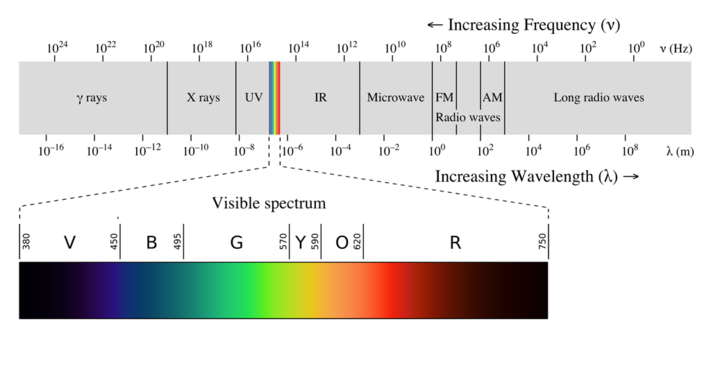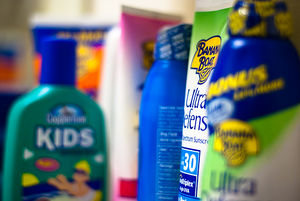Ultraviolet radiation: Difference between revisions
No edit summary |
J.williams (talk | contribs) m (1 revision imported) |
(No difference)
| |
Revision as of 01:47, 13 November 2015
Ultraviolet radiation (UV) is a type of radiant energy, much like the light we see, but with a smaller wavelength and therefore higher energy. It is defined as the light in the spectrum of wavelengths between 40-400 nanometers.[1] This means that it lies between visible light and x-rays on the electromagnetic spectrum as seen in Figure 1.

Types of UV and their effects
There are different sub-categories of UV radiation: Vacuum UV, Far UV, UVC, UVB and UVA. The first three mentioned are almost never encountered on Earth as they are absorbed by the atmosphere, however the last two, UVB and UVA are encountered very frequently.
UVA
UVA radiation is in the range of wavelengths 320-400 nm, therefore it is lower energy than other types of ultraviolet radiation, but can still cause harm to humans. Initial exposure to it gives a pigment-darkening effect to human skin (tanning), but overexposure can cause sunburn, toughening of skin, cataract formation, and other unwanted effects. This is the most commonly encountered UV radiation - accounting for 95% of the UV light hitting Earth - since it penetrates the atmosphere very easily.[1][3] UVA light is used in tanning booths and phototherapy lamps.
UVB
UVB radiation is the more harmful of the two common UV categories, this is because it has enough energy to cause photochemical damage to cellular DNA.[1] Both UVA and UVB are necessary for the synthesis of vitamin D, but it is important to be exposed to them in moderation. Overexposure to UVB light causes much of the same symptoms as UVA, but it is also known to be a cause of skin cancer. Most UVB light is blocked by the ozone layer, however due to the known holes in this layer there are concerns that this will lead to an increase in skin cancer.[1][4]
Protection against UV

UV is invisible to our eyes and the effects on our skin aren't immediate, so the consequences of overexposure can very easily sneak up on someone. However, there are many ways to protect against UV radiation:
- Eye protection is important while working with UV radiation sources which present the potential of harmful eye exposure. Sunglasses come with various defenses built in, so it is important to wear these when dealing with UV radiation.
- Protective clothing is a very simple solution, and can include long pants, hats, and long-sleeved shirts. Some newer, sun-resistant fabrics are more efficient in blocking UV radiation.
- Sunscreen is extremely important when in contact with the sun, and is rated by its Sun Protection Factor (SPF), with higher SPF values corresponding to better protection blocking up to nearly 100% of harmful UV radiation.
There exists a "UV index" included in most weather forecasts which help people to prepare for the harmful rays. Environment Canada has a useful table for understanding the UV index, available here.
References
- ↑ 1.0 1.1 1.2 1.3 Health Physics Society, Ultraviolet Radiation [Online], Available: http://hps.org/hpspublications/articles/uv.html
- ↑ P. Ronan, Gringer. (2013, February 19). EM spectrum revised [Online]. Available: http://upload.wikimedia.org/wikipedia/commons/3/30/EM_spectrumrevised.png
- ↑ CCOHS, Ultraviolet Radiation [Online], Available: http://www.ccohs.ca/oshanswers/phys_agents/ultravioletradiation.html
- ↑ NOAA, Science: Ozone Basics [Online], Available: http://www.ozonelayer.noaa.gov/science/basics.htm
- ↑ Robert S. Donovan via Flickr [Online], Available: https://www.flickr.com/photos/booleansplit/3488882849/

